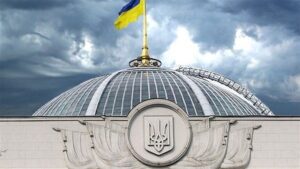
In March-April 2022, the Synevo laboratory paid UAH 35 million in taxes and fees to the budget, commercial director of the Synevo laboratory Mykola Skavronsky said.
“For March and April 2022, the Synevo company still paid about UAH 35 million in taxes and fees to the state,” he wrote on his Facebook page.
Skavronsky also said that in March and April 2022, the Synevo laboratory paid UAH 67 million to its employees “1.5 times more money than the entire revenue for these two months”, the total cash receipts of Synevo during this time amounted to UAH 47 million.
“Financial support for our employees in the first months of the war was provided exclusively at the expense of Synevo’s own reserves,” Skavronsky wrote.
Synevo is the largest network of laboratories in Ukraine, part of the Swedish medical holding Medicover. The Synevo network includes 320 laboratory centers operating in 125 settlements of Ukraine, as well as eight laboratories that perform more than 1,000 types of tests.
Every year, the company’s laboratory centers serve more than 4 million customers.

The state should immediately stop the practice of registering tax invoices in Ukraine, including the assessment of criteria for classifying enterprises as those with risky activities, and also replacing value added tax (VAT) with a tax on withdrawn capital.
Dmytro Nikiforov, the owner and founder of AT Market LLC (Kyiv), which is engaged in bottling high-mountainous Carpathian water under the trademarks Voda UA, Goryanka, Karpatska Dzherelna Vysokohirna, expressed such an opinion in an interview with the Interfax-Ukraine agency.
At the same time, he believes that the rate of taxes levied in the country is feasible for business and does not need to be reduced.
“We need to immediately kill this ‘hydra,’ which is called the registration of tax invoices. This is the tool by which thieving tax officials and MP who back them ‘wash out’ the turnover from businesses in the amount of VAT. The state must immediately stop the practice of registering tax invoices, which does not exist anywhere in the world,” Nikiforov said.
According to him, the practice of registering tax invoices and the procedure for determining the criteria for classifying the activities of enterprises as risky harm business, washing out its working capital, and should be stopped immediately.
“There is no need to lower taxes, they are feasible. By and large, VAT should be abolished in principle, and a clear and understandable turnover tax and non-refundable sales tax should be introduced. Because any refundable tax like VAT is a so-called square tax and creates corruption risks, but such people control this issue that it is impossible to move it,” the businessman specified.
“Therefore, the abolition of VAT and income tax with a replacement for a tax on withdrawn capital is what the state should do for business. Without this, business will not be cured, no matter how it is stuffed with loans. All funding is broken down by the fact that in the existing paradigm it simply cannot work,” Nikiforov added.
As reported, Finance Minister Serhiy Marchenko supports restoring the VAT administration system with automatic cash reimbursement, “even if it is painful and requires payment deferral.”
“For some reason, decisions were made that actually broke the current system of registering tax invoices, checking risks and automatic budgetary VAT refunds. In fact, since March, our system for registering tax invoices has not been working … I am a supporter of the system of automatic VAT refunds working, and business receiving funds,” he said in an interview with Interfax-Ukraine.
On February 28, the Cabinet of Ministers of Ukraine established the possibility of automatic registration of tax invoices for certain types of agribusiness and food industry enterprises, which will allow them to submit documentation without bureaucratic delays.
According to Roman Leschenko, who at that time was the Minister of Agrarian Policy and Food of Ukraine, after February 28, tax invoices of legal entities growing crops, farm animals and poultry, engaged in fishing, and processing milk, butter and cottage cheese are automatically registered.
In addition, the list includes all enterprises producing meat, fruit and vegetable juices, vegetable oil, animal fats, edible fats; products of the flour-grinding industry; bread and bakery products, flour confectionery, cakes and pastries; cocoa, chocolate, sugar confectionery; tea and coffee; spices and seasonings; prepared food and dishes; baby and dietary food; prepared feed for animals kept on farms; soft drinks and other bottled waters.

The Verkhovna Rada adopted bill No. 7232 as a basis, which provides for the application of a coefficient of 1.5 to the rates of corporate income tax, environmental tax, rent and property tax for companies that refused to leave the Russian market. 309 people’s deputies voted for the corresponding bill in the first reading on Friday, with the required 226 votes, Yaroslav Zheleznyak, deputy head of the committee on finance, tax and customs policy, said on his Telegram channel.

Ferrexpo’s enterprises (Poltava Mining, Yeristovo Mining and Belanovo Mining) in January-September 2021 transferred more than UAH 6.6 billion in taxes and fees to the budgets of different levels, which is 2.7 times more than in the same period in 2020, the company said in a statement on Tuesday.
“The increase in payments occurred in all items, but the largest one was income tax,” Ferrexpo told Interfax-Ukraine.
At the end of January-September 2020, the company reported an increase in taxes and fees paid to more than $2.45 billion.
Ferrexpo said that Poltava Mining paid UAH 4.87 billion (a year earlier it was UAH 1.92 billion), Yeristovo Mining paid UAH 1.8 billion (UAH 0.51 billion) and Belanovo Mining paid UAH 0.03 billion (UAH 0.013 billion).
Taking into account the previously published data for 9M 2020 and excluding Belanovo Mining for 9M 2021, payments to local budgets grew by 19.3%, to UAH 333.6 million, to regional budgets by 2.6 times, to 784.1 UAH million, and to the state budget by 3.4 times, to UAH 5.22 billion. The social security contribution payments grew by 3.2%, to UAH 328.1 million.
Ferrexpo said that (excluding Belanovo Mining) income tax increased 4.7 times, to UAH 4.95 billion, environmental tax rose by 37.6%, to UAH 158.5 million, personal income tax grew by 5, 2%, to UAH 293.7 million, subsoil use royalties by 65.1%, to UAH 792.5 million.
Ferrexpo is an iron ore company with assets in Ukraine, which each owns 100% of Poltava Mining and Yeristovo Mining and 99.9% of Belanovo Mining.
Ferrexpo in January-September 2021 increased its total pellet production by 0.3% compared to the same period in 2020, to 8.158 million tonnes.
In the first half of 2021, the company increased its revenue by 74.3%, to $1.353 billion, and net profit by 2.7 times, to $661.43 million.

The Association of Taxpayers of Ukraine has announced the results of the rating “Honest Taxpayers – 2020”. For the second year in a row, the Avtostrada Group of Companies won in the Road Construction category.
The High Rating Commission assessed, in particular, the completeness and timeliness of taxes and fees payment, compliance with tax discipline, the number of officially employed persons, participation in social programs and charity events, and more.
Avtostrada Group of Companies is one of the largest taxpayers in the road construction sector of Ukraine. The company undergoes an annual audit of financial statements in accordance with international standards, having transparent business conduct and social responsibility as key priorities.
“Transparent business management, audit of financial statements according to international standards, high level of tax burden, full and timely payment of all taxes and fees – these are main company’s principles from the first days of its establishment. And it’s such a pleasure that our approach is praised by independent experts. Paid taxes are an investment in the country’s welfare and a contribution to our future. I’m grateful to the Taxpayers’ Association for the important initiative and organization of the rating!” – Maksym Shkil, the founder of the Avtostrada Group of Companies, commented on the award.
The Association has been determining the nominations for 10 years, and it’s an anniversary rating. The main purpose of the rating is to strengthen the role and authority of the taxpayer and increase the overall culture of tax payment in Ukraine.

The Cabinet of Ministers of Ukraine plans to exempt air carriers from taxation on internal flights, Prime Minister Denys Shmyhal said.
“In order to enhance travel within the country, we plan to exempt air carriers from taxation on such routes. This step will reduce the costs of companies and cut the cost of air tickets for internal flights. Ukrainians, for their part, will have greater access to fast travel around the country,” Shmyhal said on Facebook on Sunday, April 25.
According to him, for this it is necessary to amend the current legislation. “I have already set this task for the ministries,” the head of government said.
The prime minister said the government also discussed the issue of intensifying cooperation in the tourism sector with Turkey. “We set a goal not only to expand sea and air traffic in order to open new and convenient routes for Ukrainians, but also to encourage Turkish citizens to come to Ukraine for family vacations,” Shmyhal said.